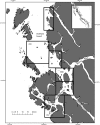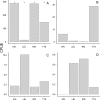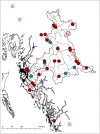Juvenile salmon usage of the Skeena River estuary
- PMID: 25749488
- PMCID: PMC4352006
- DOI: 10.1371/journal.pone.0118988
Juvenile salmon usage of the Skeena River estuary
Abstract
Migratory salmon transit estuary habitats on their way out to the ocean but this phase of their life cycle is more poorly understood than other phases. The estuaries of large river systems in particular may support many populations and several species of salmon that originate from throughout the upstream river. The Skeena River of British Columbia, Canada, is a large river system with high salmon population- and species-level diversity. The estuary of the Skeena River is under pressure from industrial development, with two gas liquefaction terminals and a potash loading facility in various stages of environmental review processes, providing motivation for understanding the usage of the estuary by juvenile salmon. We conducted a juvenile salmonid sampling program throughout the Skeena River estuary in 2007 and 2013 to investigate the spatial and temporal distribution of different species and populations of salmon. We captured six species of juvenile anadromous salmonids throughout the estuary in both years, and found that areas proposed for development support some of the highest abundances of some species of salmon. Specifically, the highest abundances of sockeye (both years), Chinook in 2007, and coho salmon in 2013 were captured in areas proposed for development. For example, juvenile sockeye salmon were 2-8 times more abundant in the proposed development areas. Genetic stock assignment demonstrated that the Chinook salmon and most of the sockeye salmon that were captured originated from throughout the Skeena watershed, while some sockeye salmon came from the Nass, Stikine, Southeast Alaska, and coastal systems on the northern and central coasts of British Columbia. These fish support extensive commercial, recreational, and First Nations fisheries throughout the Skeena River and beyond. Our results demonstrate that estuary habitats integrate species and population diversity of salmon, and that if proposed development negatively affects the salmon populations that use the estuary, then numerous fisheries would also be negatively affected.
Conflict of interest statement
Figures








Similar articles
-
Evidence of disruption in estrogen-associated signaling in the liver transcriptome of in-migrating sockeye salmon of British Columbia, Canada.Comp Biochem Physiol C Toxicol Pharmacol. 2013 Mar;157(2):150-61. doi: 10.1016/j.cbpc.2012.10.007. Epub 2012 Oct 25. Comp Biochem Physiol C Toxicol Pharmacol. 2013. PMID: 23103762
-
Evaluating relationships between wild Skeena river sockeye salmon productivity and the abundance of spawning channel enhanced sockeye smolts.PLoS One. 2014 Apr 23;9(4):e95718. doi: 10.1371/journal.pone.0095718. eCollection 2014. PLoS One. 2014. PMID: 24760007 Free PMC article.
-
Sea louse infection of juvenile sockeye salmon in relation to marine salmon farms on Canada's west coast.PLoS One. 2011 Feb 9;6(2):e16851. doi: 10.1371/journal.pone.0016851. PLoS One. 2011. PMID: 21347456 Free PMC article.
-
Dead fish swimming: a review of research on the early migration and high premature mortality in adult Fraser River sockeye salmon Oncorhynchus nerka.J Fish Biol. 2012 Jul;81(2):576-99. doi: 10.1111/j.1095-8649.2012.03360.x. Epub 2012 Jun 25. J Fish Biol. 2012. PMID: 22803725 Review.
-
Changing estuaries and impacts on juvenile salmon: A systematic review.Glob Chang Biol. 2020 Apr;26(4):1986-2001. doi: 10.1111/gcb.14997. Epub 2020 Feb 5. Glob Chang Biol. 2020. PMID: 32020738 Free PMC article. Review.
Cited by
-
Relationships between Potentially Toxic Elements in intertidal sediments and their bioaccumulation by benthic invertebrates.PLoS One. 2019 Sep 19;14(9):e0216767. doi: 10.1371/journal.pone.0216767. eCollection 2019. PLoS One. 2019. PMID: 31536494 Free PMC article.
-
Physiological condition infers habitat choice in juvenile sockeye salmon.Conserv Physiol. 2024 Apr 1;12(1):coae011. doi: 10.1093/conphys/coae011. eCollection 2024. Conserv Physiol. 2024. PMID: 38584988 Free PMC article.
References
-
- Healey MC. Utilization of the Nanaimo river estuary by juvenile Chinook salmon, Oncorynchus tsawytscha. Fish Bull 1980;77: 653–668.
-
- Levy DA, Northcote TG. Juvenile salmon residency in a marsh area of the Fraser River estuary. Can J Fish Aquat Sci. 1982; 270–276.
-
- Iwata M, Komatsu S. Importance of estuarine residence for adaptation of chum salmon (Oncorhynchus keta) fry to seawater. Can J Fish Aquat Sci. 1984;41: 1–6.
-
- Parker RR. Marine mortality schedules of pink salmon of the Bella Coola river, central British Colurnbia. J Fish Res Bd Can. 1968;25: 757–794.
-
- Karieva P, Marvier M, McClure M. Recovery and management options for spring/summer Chinook salmon in the Columbia River basin. Science. 2010;290: 977–979. - PubMed
Publication types
MeSH terms
LinkOut - more resources
Full Text Sources
Other Literature Sources

